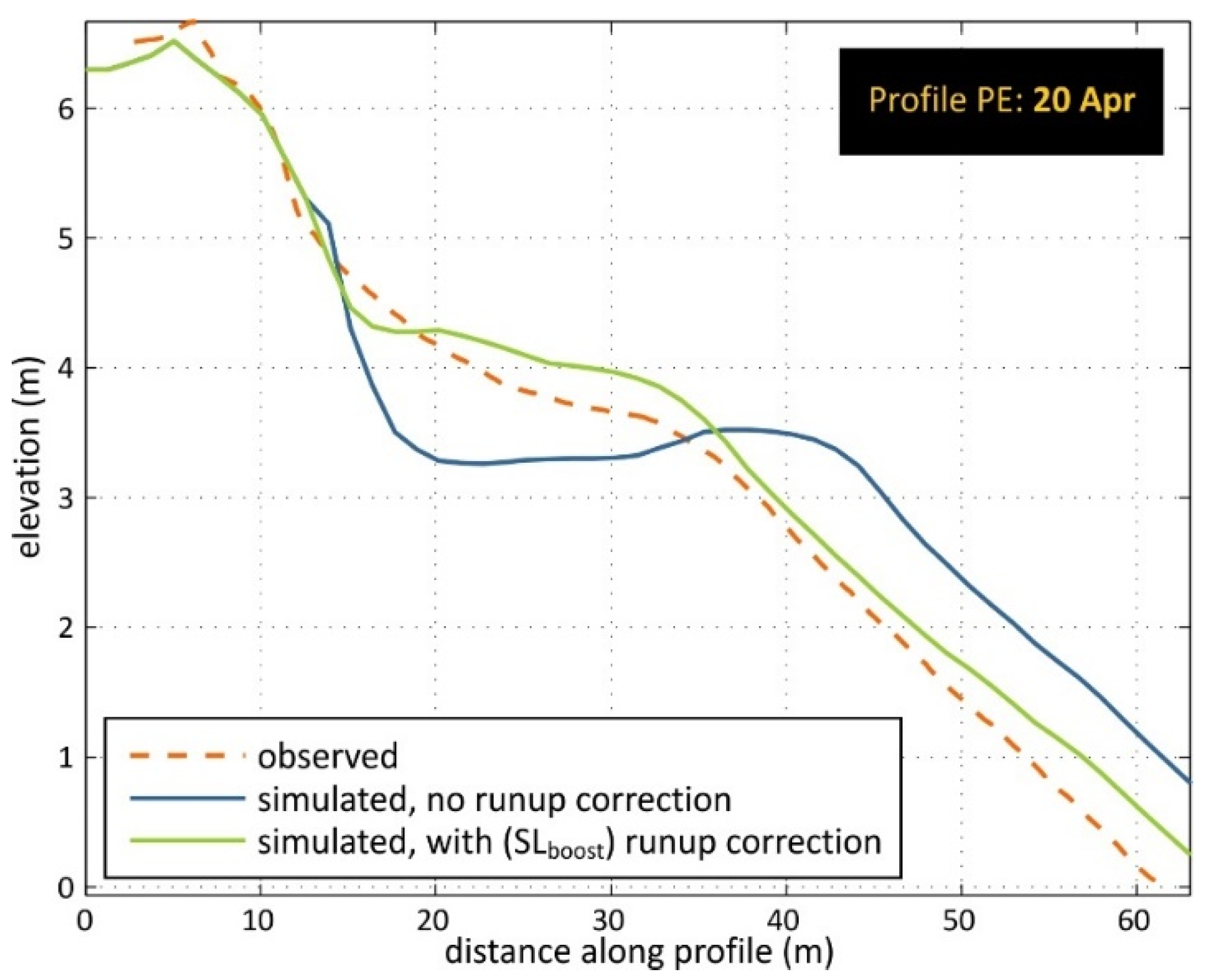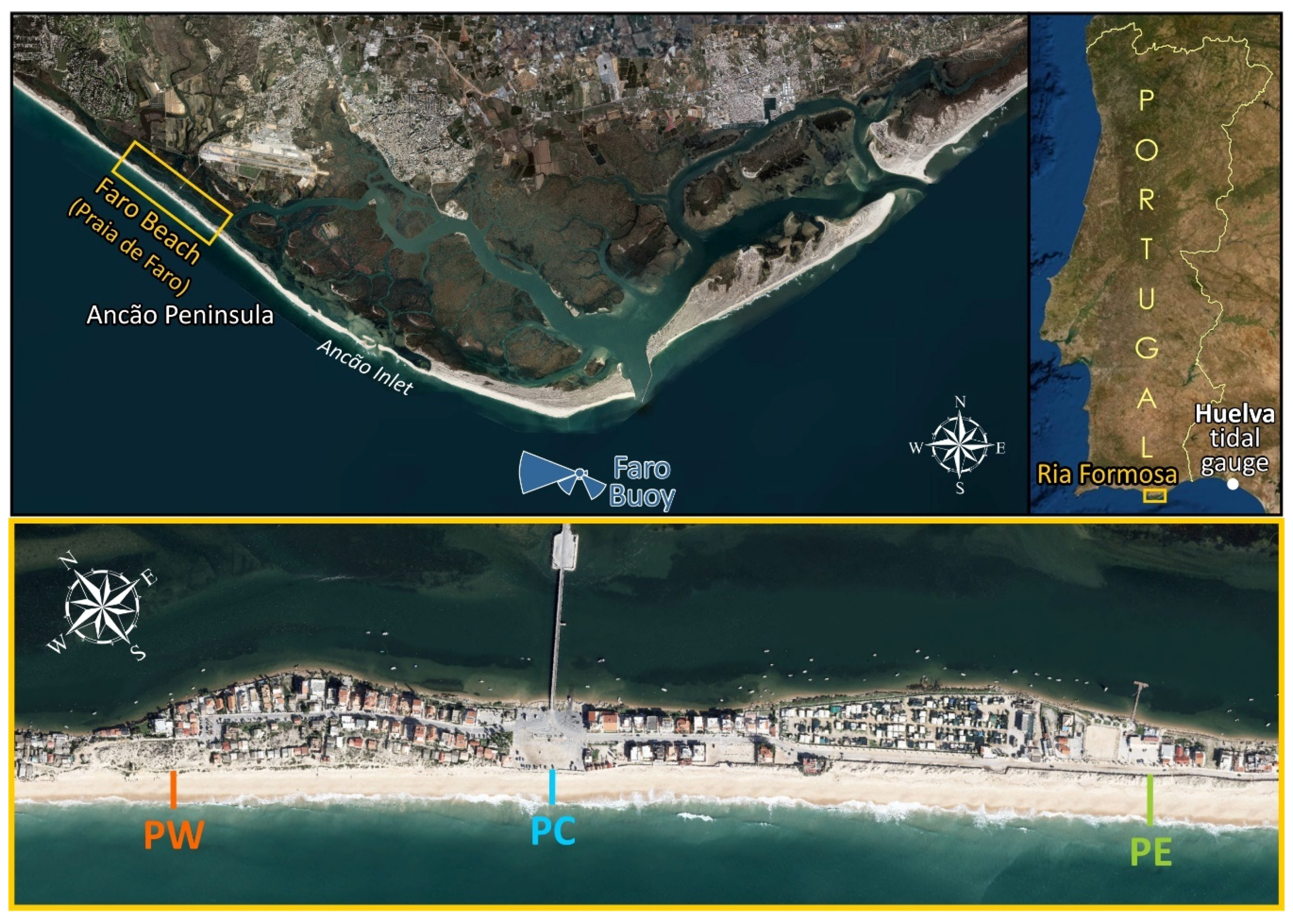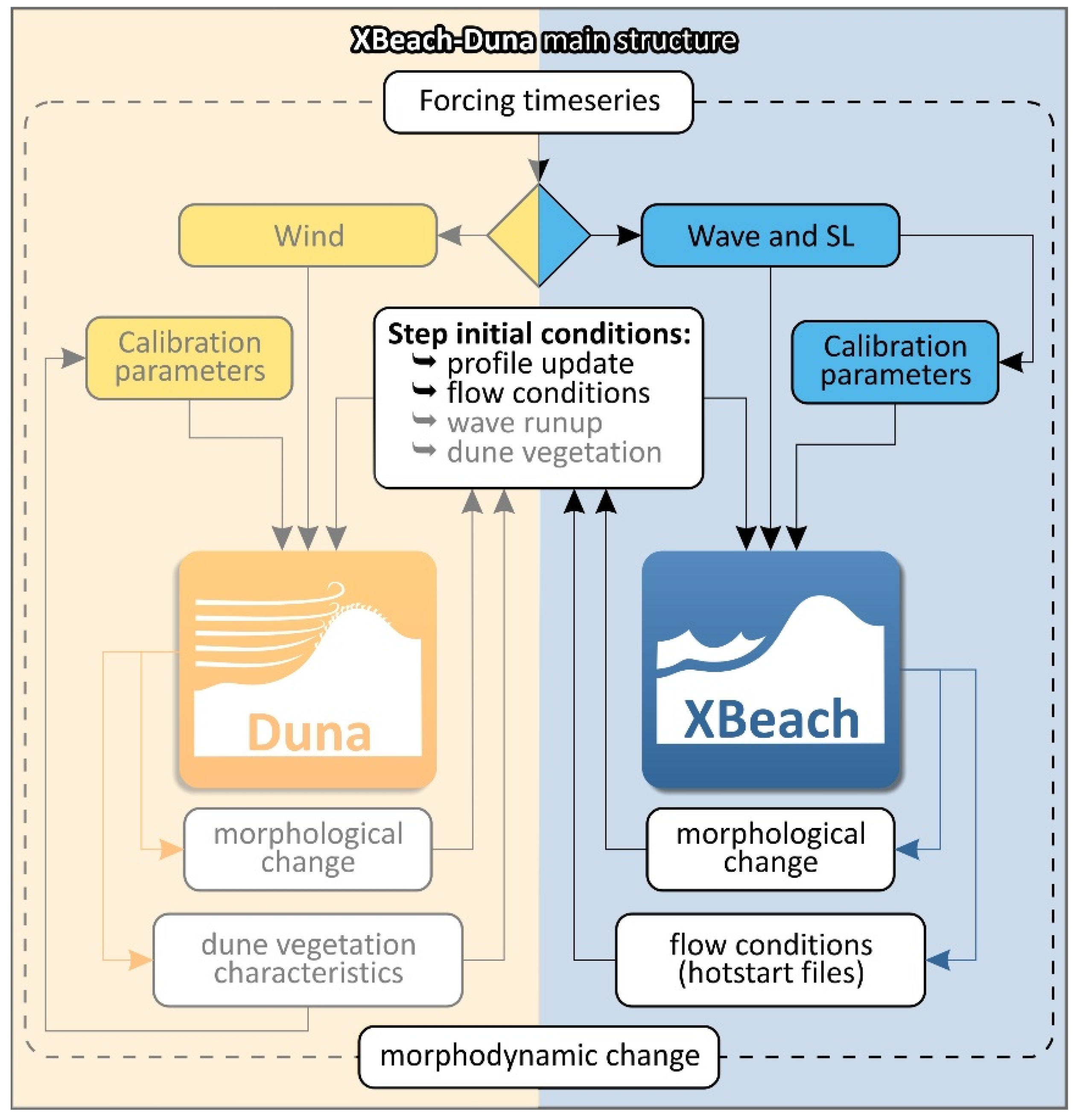Simulating Destructive and Constructive Morphodynamic Processes in Steep Beaches
Abstract
:1. Introduction
2. Pre- and Post-Storm Beach Response
2.1. Study Area
2.2. Hydrodynamic Data
2.3. Morphological Changes
3. Morphodynamic Modelling
3.1. Modelling Approach
3.2. Calibration Parameters
3.3. Runup Correction
4. Results
4.1. Model Calibration
4.2. Model Sensitivity
5. Discussion
6. Conclusions
- The results are novel and promising regarding the ability of a fully process-based model to reproduce post-storm recovery. XBeach performed well under challenging conditions, not only in terms of operating beyond the original model design (recovery under mild wave conditions), but also in terms of morphologic requirements of the recovered beach profiles (steep and high berms).
- The simplified approach to improve runup underestimation by the surfbeat mode of XBeach performed well for constant waves propagating on idealized beach profiles, as well as using real wave time-series and simulated morphodynamics. The related improvement of simulated beach response under mild wave conditions and steepening foreshore slopes was decisive regarding the height and shape of the recovered berm.
- Two calibration parameters were used, bermslope and facua. The former is a heuristic transport term, designed specifically to nudge the profile in the narrow area of the swash zone toward the assigned value, that was key for retrieving the steep slopes during the recovery phase. The latter is a factor that tunes the impact of wave skewness and asymmetry that allowed to enhance onshore sand transfer. The model sensitivity to the calibration parameters was, expectedly, relatively high.
- The experiments were purposefully not over-calibrated, sacrificing potential skill improvement for a generic solution, and using a set of two, fixed-value, calibration parameter groups, corresponding to destructive and constructive conditions. This will improve comparability with experiments using schematized wave forcing and allow to isolate the loss of skill introduced by the schematization.
- Building upon these results and using wave schematization techniques, we plan to formulate approaches for modelling medium-term beach morphodynamics.
Author Contributions
Funding
Institutional Review Board Statement
Informed Consent Statement
Data Availability Statement
Acknowledgments
Conflicts of Interest
Appendix A

References
- Karunarathna, H.; Horrillo-Caraballo, J.; Kuriyama, Y.; Mase, H.; Ranasinghe, R.; Reeve, D.E. Linkages between sediment composition, wave climate and beach profile variability at multiple timescales. Mar. Geol. 2016, 381, 194–208. [Google Scholar] [CrossRef]
- Castelle, B.; Bujan, S.; Ferreira, S.; Dodet, G. Foredune morphological changes and beach recovery from the extreme 2013/2014 winter at a high-energy sandy coast. Mar. Geol. 2017, 385, 41–55. [Google Scholar] [CrossRef]
- Toimil, A.; Losada, I.J.; Nicholls, R.J.; Dalrymple, R.A.; Stive, M.J.F. Addressing the challenges of climate change risks and adaptation in coastal areas: A review. Coast. Eng. 2020, 156, 103611. [Google Scholar] [CrossRef]
- Karunarathna, H.; Brown, J.; Chatzirodou, A.; Dissanayake, P.; Wisse, P. Multi-timescale morphological modelling of a dune-fronted sandy beach. Coast. Eng. 2018, 136, 161–171. [Google Scholar] [CrossRef]
- Fernández-Montblanc, T.; Duo, E.; Ciavola, P. Dune reconstruction and revegetation as a potential measure to decrease coastal erosion and flooding under extreme storm conditions. Ocean Coast. Manag. 2020, 188, 105075. [Google Scholar] [CrossRef]
- Scott, T.; Masselink, G.; O’Hare, T.; Saulter, A.; Poate, T.; Russell, P.; Davidson, M.; Conley, D. The extreme 2013/2014 winter storms: Beach recovery along the southwest coast of England. Mar. Geol. 2016, 382, 224–241. [Google Scholar] [CrossRef]
- Houser, C.; Wernette, P.; Rentschlar, E.; Jones, H.; Hammond, B.; Trimble, S. Post-storm beach and dune recovery: Implications for barrier island resilience. Geomorphology 2015, 234, 54–63. [Google Scholar] [CrossRef]
- Eichentopf, S.; Alsina, J.M.; Christou, M.; Kuriyama, Y.; Karunarathna, H. Storm sequencing and beach profile variability at Hasaki, Japan. Mar. Geol. 2020, 424, 106153. [Google Scholar] [CrossRef]
- Eichentopf, S.; Karunarathna, H.; Alsina, J.M. Morphodynamics of sandy beaches under the influence of storm sequences: Current research status and future needs. Water Sci. Eng. 2019, 12, 221–234. [Google Scholar] [CrossRef]
- Montreuil, A.L.; Chen, M.; Brand, E.; Verwaest, T.; Houthuys, R. Post-storm recovery assessment of urbanized versus natural sandy macro-tidal beaches and their geomorphic variability. Geomorphology 2020, 356, 107096. [Google Scholar] [CrossRef]
- Vousdoukas, M.I.; Almeida, L.P.M.; Ferreira, Ó. Beach erosion and recovery during consecutive storms at a steep-sloping, meso-tidal beach. Earth Surf. Process. Landforms 2012, 37, 583–593. [Google Scholar] [CrossRef]
- Dissanayake, P.; Brown, J.; Wisse, P.; Karunarathna, H. Effects of storm clustering on beach/dune evolution. Mar. Geol. 2015, 370, 63–75. [Google Scholar] [CrossRef]
- Ferreira, Ó.; Plomaritis, T.A.; Costas, S. Effectiveness assessment of risk reduction measures at coastal areas using a decision support system: Findings from Emma storm. Sci. Total Environ. 2019, 657, 124–135. [Google Scholar] [CrossRef] [PubMed]
- Inman, D.L.; Elwany, M.H.S.; Jenkins, S.A. Shorerise and bar-berm profiles on ocean beaches. J. Geophys. Res. 1993, 98, 18181–18199. [Google Scholar] [CrossRef]
- Bernabeu, A.M.; Medina, R.; Vidal, C. Wave reflection on natural beaches: An equilibrium beach profile model. Estuar. Coast. Shelf Sci. 2003, 57, 577–585. [Google Scholar] [CrossRef]
- Larson, M.; Kraus, N.C.; Wise, R.A. Equilibrium beach profiles under breaking and non-breaking waves. Coast. Eng. 1999, 36, 59–85. [Google Scholar] [CrossRef]
- Dodet, G.; Castelle, B.; Masselink, G.; Scott, T.; Davidson, M.; Floc’h, F.; Jackson, D.; Suanez, S. Beach recovery from extreme storm activity during the 2013-14 winter along the Atlantic coast of Europe. Earth Surf. Process. Landforms 2019, 44, 393–401. [Google Scholar] [CrossRef]
- Davidson, M.A.; Splinter, K.D.; Turner, I.L. A simple equilibrium model for predicting shoreline change. Coast. Eng. 2013, 73, 191–202. [Google Scholar] [CrossRef]
- Robinet, A.; Idier, D.; Castelle, B.; Marieu, V. A reduced-complexity shoreline change model combining longshore and cross-shore processes: The LX-Shore model. Environ. Model. Softw. 2018, 109, 1–16. [Google Scholar] [CrossRef]
- Vitousek, S.; Barnard, P.L.; Limber, P.; Erikson, L.; Cole, B. A model integrating longshore and cross-shore processes for predicting long-term shoreline response to climate change. J. Geophys. Res. Earth Surf. 2017, 122, 782–806. [Google Scholar] [CrossRef]
- Roelvink, D.; Huisman, B.; Elghandour, A.; Ghonim, M.; Reyns, J. Efficient modeling of complex sandy coastal evolution at monthly to century time scales. Front. Mar. Sci. 2020, 7, 535. [Google Scholar] [CrossRef]
- Ranasinghe, R.; Holman, R.; De Schipper, M.; Lippmann, T.; Wehof, J.; Duong, T.M.; Roelvink, D.; Stive, M. Quantifying nearshore morphological recovery time scales using ARGUS video imaging: Palm Beach, Sydney and Duck, North Carolina. Coast. Eng. Proc. 2012, 1, 24. [Google Scholar] [CrossRef]
- Robinet, A.; Castelle, B.; Idier, D.; Harley, M.D.; Splinter, K.D. Controls of local geology and cross-shore/longshore processes on embayed beach shoreline variability. Mar. Geol. 2020, 422, 106118. [Google Scholar] [CrossRef]
- Costas, S.; Ferreira, O.; Martinez, G. Why do we decide to live with risk at the coast? Ocean Coast. Manag. 2015, 118, 1–11. [Google Scholar] [CrossRef]
- Plomaritis, T.A.; Ferreira, Ó.; Costas, S. Regional assessment of storm related overwash and breaching hazards on coastal barriers. Coast. Eng. 2018, 134, 124–133. [Google Scholar] [CrossRef]
- Plomaritis, T.A.; Costas, S.; Ferreira, Ó. Use of a Bayesian Network for coastal hazards, impact and disaster risk reduction assessment at a coastal barrier (Ria Formosa, Portugal). Coast. Eng. 2018, 134, 134–147. [Google Scholar] [CrossRef]
- Dias, J.A.; Ferreira, Ó.; Matias, A.; Vila-Concejo, A.; Sá-Pires, C. Evaluation of Soft Protection Techniques in Barrier Islands by Monitoring Programs: Case Studies from Ria Formosa (Algarve-Portugal). J. Coast. Res. 2003, SI35, 117–131. [Google Scholar]
- Achab, M.; Ferreira, Ó.; Alveirinho Dias, J.M. Evaluation of sedimentological and morphological changes induced by the rehabilitation of sandy beaches from the Ria Formosa Barrier Island System (South Portugal). Thalassas 2014, 30, 21–31. [Google Scholar]
- Kombiadou, K.; Matias, A.; Ferreira, Ó.; Carrasco, A.R.; Costas, S.; Plomaritis, T. Impacts of human interventions on the evolution of the Ria Formosa barrier island system (S. Portugal). Geomorphology 2019, 343, 129–144. [Google Scholar] [CrossRef]
- Costas, S.; Ramires, M.; de Sousa, L.B.; Mendes, I.; Ferreira, O. Surficial sediment texture database for the south-western Iberian Atlantic margin. Earth Syst. Sci. Data 2018, 10, 1185–1195. [Google Scholar] [CrossRef]
- Costa, M.; Silva, R.; Vitorino, J. Contribuição para o Estudo do Clima de Agitação Marítima na Costa Portuguesa (in Portuguese). In Proceedings of the 2as Jornadas Portuguesas de Engenharia Costeira e Portuária, International Navigation Association PIANC, Sines, Portugal, 17–19 October 2001. [Google Scholar]
- Costas, S.; de Sousa, L.B.; Kombiadou, K.; Ferreira, Ó.; Plomaritis, T.A. Exploring foredune growth capacity in a coarse sandy beach. Geomorphology 2020, 371, 107435. [Google Scholar] [CrossRef]
- Oliveira, T.C.A.; Neves, M.G.; Fidalgo, R.; Esteves, R. Variability of wave parameters and Hmax/Hs relationship under storm conditions offshore the Portuguese continental coast (under revision). Ocean Eng. 2018, 153, 10–22. [Google Scholar] [CrossRef]
- Plomaritis, T.A.; Benavente, J.; Laiz, I.; Del Río, L. Variability in storm climate along the Gulf of Cadiz: The role of large scale atmospheric forcing and implications to coastal hazards. Clim. Dyn. 2015, 45, 2499–2514. [Google Scholar] [CrossRef]
- Almeida, L.P.; Ferreira, Ó.; Taborda, R. Geoprocessing tool to model beach erosion due to storms: Application to Faro beach (Portugal). J. Coast. Res. 2011, 64, 1830–1834. [Google Scholar]
- Ferreira, Ó.; Garcia, T.; Matias, A.; Taborda, R.; Dias, J.A. An integrated method for the determination of set-back lines for coastal erosion hazards on sandy shores. Cont. Shelf Res. 2006, 26, 1030–1044. [Google Scholar] [CrossRef]
- Almeida, L.P.; Ferreira, Ó.; Vousdoukas, M.I.; Dodet, G. Historical variation and trends in storminess along the Portuguese South Coast. Nat. Hazards Earth Syst. Sci. 2011, 11, 2407–2417. [Google Scholar] [CrossRef]
- Faro Municipal Council - Organization. Available online: https://www.cm-faro.pt/pt/menu/112/como-nos-organizamos.aspx#departamento-de-infraestruturas-e-urbanismo (accessed on 8 October 2020).
- Roelvink, D.; Costas, S. Coupling nearshore and aeolian processes: XBeach and Duna process-based models. Environ. Model. Softw. 2019, 115, 98–112. [Google Scholar] [CrossRef]
- Roelvink, D.; van Dongeren, A.; Mccall, R.; Hoonhout, B.; van Rooijen, A.; van Geer, P.; de Vet, L.; Nederhoff, K. Xbeach Manual; Deltares: Delft, The Netherlands, 2015. [Google Scholar]
- Roelvink, D. Dissipation in random wave groups incident on a beach. Coast. Eng. 1993, 19, 127–150. [Google Scholar] [CrossRef]
- Roelvink, J.A. Coastal morphodynamic evolution techniques. Coast. Eng. 2006, 53, 277–287. [Google Scholar] [CrossRef]
- Ruessink, B.G.; Ramaekers, G.; Van Rijn, L.C. On the parameterization of the free-stream non-linear wave orbital motion in nearshore morphodynamic models. Coast. Eng. 2012, 65, 56–63. [Google Scholar] [CrossRef]
- de Beer, A.F.; McCall, R.T.; Long, J.W.; Tissier, M.F.S.; Reniers, A.J.H.M. Simulating wave runup on an intermediate–reflective beach using a wave-resolving and a wave-averaged version of XBeach. Coast. Eng. 2020, 163, 103788. [Google Scholar] [CrossRef]
- Roelvink, D.; McCall, R.; Mehvar, S.; Nederhoff, K.; Dastgheib, A. Improving predictions of swash dynamics in XBeach: The role of groupiness and incident-band runup. Coast. Eng. 2018, 134, 103–123. [Google Scholar] [CrossRef]
- Stockdon, H.F.; Holman, R.A.; Howd, P.A.; Sallenger, A.H. Empirical parameterization of setup, swash, and runup. Coast. Eng. 2006, 53, 573–588. [Google Scholar] [CrossRef]
- Brier, G.W. Verification of Forecasts Expressed in Terms of Probability. Mon. Weather Rev. 1950, 78, 1–3. [Google Scholar] [CrossRef]
- Kalligeris, N.; Smit, P.B.; Ludka, B.C.; Guza, R.T.; Gallien, T.W. Calibration and assessment of process-based numerical models for beach profile evolution in southern California. Coast. Eng. 2020, 158, 103650. [Google Scholar] [CrossRef]
- Stockdon, H.F.; Thompson, D.M.; Plant, N.G.; Long, J.W. Evaluation of wave runup predictions from numerical and parametric models. Coast. Eng. 2014, 92, 1–11. [Google Scholar] [CrossRef]
- Jongedijk, C.E. Improving XBeach Non-Hydrostatic Model Predictions of the Swash Morphodynamics of Intermediate-Reflective Beaches. Master’s Thesis, Delft University of Technology, Delft, The Netherlands, 2017. [Google Scholar]
- Pender, D.; Karunarathna, H. A statistical-process based approach for modelling beach profile variability. Coast. Eng. 2013, 81, 19–29. [Google Scholar] [CrossRef]
- Roelvink, D.; McCall, R.; Costas, S.; Van Der Lugt, M. Controlling swash zone slope is key to beach profile modelling. In Proceedings of the 9th International Conference Coastal Sediments 2019, Tampa/St. Petersburg, FL, USA, 27–31 May 2019; Wang, P., Rosati, J.D., Vallee, M., Eds.; World Scientific Publishing Co. Pte. Ltd.: Singapore, 2019; pp. 149–157. [Google Scholar]
- Simmons, J.A.; Splinter, K.D.; Harley, M.D.; Turner, I.L. Calibration data requirements for modelling subaerial beach storm erosion. Coast. Eng. 2019, 152, 103507. [Google Scholar] [CrossRef]









| Profile | ||||
|---|---|---|---|---|
| Period/Date | PW | PC | PE | |
| Volume change {m3/m (m3/m2)} | 26 February to 2 March | −52.21 (−1.45) | −56.82 (−1.68) | −54.32 (−1.06) |
| 2 March to 20 April | 47.86 (1.33) | 44.16 (1.31) | 36.67 (0.72) | |
| 2 March to 8 March | 24.17 (0.67) | 14.85 (0.44) | 2.19 (0.04) | |
| 8 March to 6 April | 15.23 (0.42) | 38.99 (1.15) | 34.48 (0.67) | |
| 6 April to 20 April | 8.46 (0.24) | −9.68 (−0.29) | ||
| Beachface slope, βf (%) | 26 February | 13.7 | 16.1 | 15.2 |
| 2 March | 5.6 | 5.0 | 6.4 | |
| 8 March | 11.0 | 6.7 | 6.6 | |
| 6 April | 13.2 | 14.7 | - | |
| 20 April | 13.8 | 12.6 | 13.3 | |
| XBeach Parameters | ||
|---|---|---|
| Name | Description | Parameterization/Value |
| break | wave breaking formulation | roelvink2 [41] |
| gamma | breaker parameter | 0.55 |
| gammax | maximum ratio wave height to water depth | 0.2 |
| maxbrsteep | maximum wave steepness criterium | 0.3 |
| waveform | wave shape model | ruessink_vanrijn [43] |
| turb | turbulence variance at the bed | wave_averaged |
| bedfriction | bed friction formulation | manning |
| bedfriccoef | bed friction coefficient (manning n) | 0.025 for sand 0.05 over riprap wall |
| facua | calibration factor for time averaged flows due to wave skewness and asymmetry | variable |
| bermslope | calibration factor for swash zone slope | variable (~βf) |
| Calibration Parameters | PW | PC | PE | |
|---|---|---|---|---|
| storm | facua | 0.75 | 0.65 | 0.75 |
| non-storm | bermslope | 0.18 | 0.18 | 0.18 |
| facua | 0.4 | 0.4 | 0.28 | |
| goodness of fit | ||||
| RMSE (m) | 02 Mar | 1.77 | 0.99 | 1.88 |
| 08 Mar | 3.57 | 2.39 | 1.14 | |
| 06 Apr | 1.54 | 3.45 | no data | |
| 20 Apr | 0.94 | 1.18 | 1.7 | |
| Vsim − Vobs (m3/m) | 02 Mar | −0.96 | −0.18 | −5.95 |
| 08 Mar | −18.4 | 0.79 | 1.14 | |
| 06 Apr | 9.04 | 3.45 | no data | |
| 20 Apr | 7.26 | −3.97 | 9.67 | |
Publisher’s Note: MDPI stays neutral with regard to jurisdictional claims in published maps and institutional affiliations. |
© 2021 by the authors. Licensee MDPI, Basel, Switzerland. This article is an open access article distributed under the terms and conditions of the Creative Commons Attribution (CC BY) license (http://creativecommons.org/licenses/by/4.0/).
Share and Cite
Kombiadou, K.; Costas, S.; Roelvink, D. Simulating Destructive and Constructive Morphodynamic Processes in Steep Beaches. J. Mar. Sci. Eng. 2021, 9, 86. https://doi.org/10.3390/jmse9010086
Kombiadou K, Costas S, Roelvink D. Simulating Destructive and Constructive Morphodynamic Processes in Steep Beaches. Journal of Marine Science and Engineering. 2021; 9(1):86. https://doi.org/10.3390/jmse9010086
Chicago/Turabian StyleKombiadou, Katerina, Susana Costas, and Dano Roelvink. 2021. "Simulating Destructive and Constructive Morphodynamic Processes in Steep Beaches" Journal of Marine Science and Engineering 9, no. 1: 86. https://doi.org/10.3390/jmse9010086
APA StyleKombiadou, K., Costas, S., & Roelvink, D. (2021). Simulating Destructive and Constructive Morphodynamic Processes in Steep Beaches. Journal of Marine Science and Engineering, 9(1), 86. https://doi.org/10.3390/jmse9010086







